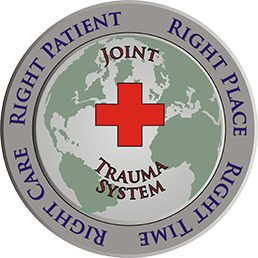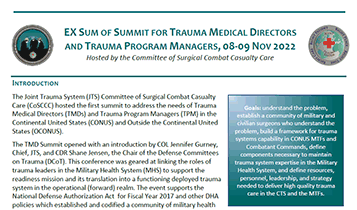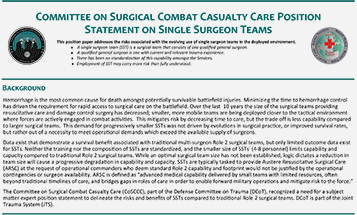CoSCCC News
JTS Committee of Surgical Combat Casualty Care (CoSCCC) Advises DoD/DHA Leadership on Orthopedic Surgical Needs for Future Combat Operations
February 4, 2025
As the DoD expert on trauma care, the JTS has released a statement outlining the orthopedic surgical needs, requirements, and resources for providing optimal care of wounded warriors in future large scale combat operations (LSCO). Proper orthopedic care is critical as high rates of orthopedic injuries are anticipated in LSCO with large numbers of casualties, multiple mass casualty incidents, and delays in evacuation. Extremity injuries that do not receive adequate surgical management in the deployed theater will result in increased morbidities to include infection, amputation, loss of extremity function, chronic pain, disability, and overall force attrition. Read about how this growing issue impacts our troops and what we can do to prepare for tomorrow's conflicts.
Highlights from the CoSCCC Mar 2024 Meeting
Preparing Capabilities for the Unknown
April 11, 2024
The future battlespace and large-scale combat operations will be unpredictable and likely characterized by a number of casualties not seen since WWII. Learning from these wars while simultaneously preparing capabilities for the unknown was the theme for 2024 Spring meeting.
Ex Sum of Summit for Trauma Medical Directors and Trauma Program Managers
May 19, 2023
The Joint Trauma System (JTS) Committee of Surgical Combat Casualty Care (CoSCCC) hosted the first summit to address the needs of Trauma Medical Directors (TMDs) and Trauma Program Managers (TPM) in the Continental United States (CONUS) and Outside the Continental United States (OCONUS).
The TMD Summit opened with an introduction by COL Jennifer Gurney, Chief, JTS, and CDR Shane Jensen, the Chair of the Defense Committees on Trauma (DCoT). This conference was geared at linking the roles of trauma leaders in the Military Health System (MHS) to support the readiness mission and its translation into a functioning deployed trauma system in the operational (forward) realm.
Committee on Surgical Combat Casualty Care (CoSCCC) Releases Statement on Neurosurgical Capability for Deployed Locations
May 19, 2023
The intent of the position statement:
- Inform the Joint Force on the best practices for care of combat casualties with traumatic brain injury and the deployment of neurosurgical capabilities during combat operations.
- There is no doctrine which requires the deployment of neurosurgical capabilities within a military theater of operations. Therefore, recommendation for a collaborative approach to develop doctrine to assist/support the Service's and the Combatant Commands with registering a deployed neurosurgical capability as a requirement.
- To improve battlefield care of service members with traumatic brain injury and other neurosurgical conditions.
CoSCCC Publishes Single Surgeon Teams Position Paper with Recommendations
February 24, 2022
This positon paper addresses the risks associated with the evolving use of single surgeon teams in the deployed environment.
- A single surgeon team (SST) is a surgical team that consists of one qualified general surgeon.
- A qualified general surgeon is one with current and relevant trauma experience.
- There has been no standardization of this capability amongst the Services.
- Employment of SST may carry more risk than fully understood.
CoSCCC Addresses Rise of Single Surgeon Teams and the Need for Neurosurgeons in Theater
January 7, 2022
The Surgical Committee met in Nov 2021 for the first in-person gathering since the COVID pandemic. CDR Shane Jensen led the meeting as the newly appointed Chair for the Surgical Committee. RDML Hancock and BG Cox were the General Officers in attendance, and the committee was presented with the deployed surgeon accounts from the tragedy at the Hamid Karzai International Airport in Kabul, Afghanistan. The presentation was both emotional and notable. The CoSCCC opened with a tribute to the former JTS Director CAPT Zsolt Stockinger. CAPT Stockinger's leadership enabled the CoSCCC and CoERCCC to stand up. After he stepped down as JTS Director he was an active, engaged and dedicated member of the CoSCCC. Members will miss his leadership and continuous challenges to identify opportunities to do the right thing for the combat casualties.
The committee had three major lines of focus on during the meeting.
- Single Surgeon Position Statement –Single surgeon teams have been a discussion at the CoSCCC since its inaugural meeting. A working group was formed by CoSCCC members to help the Services understand this capability since there has been a non-doctrinal forward austere resuscitative team frenzy to deploy untrained small teams to U.S. Central Command. The CoSCCC membership has watched the Services continue to create these teams without connecting it to a training requirement. The position statement working group was led by CAPT Tadlock and Lt Col Brian Gavitt and consisted of a tri-service panel of CoSCCC members and other subject matter experts. A position statement was using interoperability language to outline operational needs and potential risks of single surgeon teams. The main objective was to help commanders and deployed medical planners understand the risks of ad hoc single surgeon team generation in the deployed environment and to provide guidance to the Services and medical leaders who have no experience in this domain understand the capability, sustainability and risks of these untrained teams. The draft will be adjudicated by the CoSCCC and submitted for formal acceptance and publication.
- Role 3 Neurosurgical Capability Position Statement – The need for this statement arose out of conflicting opinions regarding the need for neurosurgeons in a theater or operations with low casualty volumes. There is no debate on the need for deployed neurosurgeons when there is a high operational tempo; however, given the very limited number of neurosurgeons across the force, the question arose after a the neurosurgeon was sent home from Bagram's Hospital and then required backfill after it was realized that the operational commander was not willing to take the risk of not having a neurosurgeon in theater. This multidisciplinary workgroup, with representation from Defense and Veterans Brain Injury Center, drafted a position statement outlining recommendations for an active theater of operations where U.S. casualties can be generated to have a neurosurgeon within 5 hours. If multiple R3s are in theater, each does not have to have a neurosurgeon present and the neurosurgeon had to be co-located with a CT scanner (also a requirement for a R3 MTF). Additional the statement addressed the interoperability of neurosurgeon amongst the Services. It was recommended that the deployments of neurosurgeon be based on the specialty and not based on the Service to address the previous theater where one Service primarily covered the mission.
- The third line of effort was to adjudicate the JP 4-02 proposed Trauma Lexicon Terms. Approximately 18 terms were defined and agreed on by a tri-service working group from the CoSCCC composed of both enlisted and officers. The terms were discussed, expanded on and adjudicated. They will be disseminated for voting to ultimately be incorporated into DoD Policy and Doctrine as official Military language.
Defense Committees on Trauma Conducts Inaugural Tri-Committee Conference
February 24, 2021
This past fall, the Committee on Surgical Combat Casualty Care (CoSCCC) joined forces with the Committee on EnRoute Combat Casualty Care (CoERCCC) and the Committee on Tactical Combat Casualty Care (CoTCCC) to host the first combined Defense Committee on Trauma (DCoT) conference after COVID-19 forced the committees to cancel the spring meetings.
The combined meeting presented the opportunity for the DCoTs to align strategic initiatives and ensure effective cross-functional committee work on projects and guidelines to improve combat casualty care. Members focused on ways to increase the sharing and promotion of committee publications, products and knowledge. The DCoT now has statutory authority to affect change as seen by the recent progress defining the tri-service lexicon and increased communications with the Combatant Commands (CCMDs).
The conference featured keynote speaker Tri-service General Officers General Austin Miller and a panel discussion led by Joint Staff Surgeon Brig Gen Paul Friedrichs, MC, USAF; USAMRDC Commanding General Brig. Gen. Michael J. Talley; Director of DHA Healthcare Operations Brig. Gen. George N. Appenzeller; Naval Medical Forces Atlantic Commander Rear Admiral Darin K. Via; and Naval Medical Forces Support Command Commander Rear Admiral Cynthia A. Kuehner. During the panel, Where do senior leaders see gaps for the future battlefield?, officers shared their perspectives on large scale combat operations, tri-service interoperability, and standardization. They also discussed how to swiftly implement a CCMD trauma system (CTS), especially in response to a pandemic like COVID-19.
With almost 200 military, civilian and contract attendees, the joint conference enabled subcommittees to collaborate on lines of effort. The DCoTs agreed to address:
- The integration of Tactical Combat Casualty Care hurdles and limitations for "medicine out of a back pack" and transition from point of injury to prolonged field care to en route care as well as how to successfully approach each level of care in reference to fluid resuscitation, burn management etc.
- Evaluate where DCoTs are in regards to service equities, platform availability, and minimum training standards for en route care skill level.
- Research and development with special attention to ventilation management and standardization.
The JTS Chief Col Stacy Shackelford challenged the committees to identify and prioritize the "top 10 current battlefield issues." Col Shackelford concluded the meeting with an overview of recent DHA, JTS and CTS accomplishments
Defense Committee on Trauma Conducts Inaugural Joint conference
January 10, 2020
The Committee of Surgical Combat Casualty Care joined forces with the Committee on EnRoute Combat Casualty Care to host the first combined conference in the history of the Joint Trauma System.
The Nov 2019 combined conference focused its discussion on Department of Defense (DoD) initiatives to address trauma skill sustainment. The conference agenda headlined with attendance from many Tri-service General Officers. Officers shared their perspectives on how "post major conflict" brings another round of scrutiny on the DoD's trauma readiness skills.
The joint conference enabled cross-functional subcommittees to collaborate on lines of effort with subject matter experts from both surgical and enroute community leaders. Some of the immediate action items and due-outs from the committees are the publication of an Austere Anesthesia CPG, Standardization for Austere Surgical Team training, Pre-hospital EnRoute Care Protocols, Research Priority Manuscript, and the convergence of Tri-service protocols.
The JTS Chief Col Stacy Shackelford challenged the two committees to address the remaining "Top 10 CURRENT Battlefield Issues" proposed March 2019, leading with issue #1 to improve capability and capacity for whole blood transfusion throughout the continuum. Col Shackelford concluded the meeting with an overview of recent accomplishments by Military Medicine.
"We are making a difference," noted Shackelford. "There are multiple lines of effort in various stages of implementation to address trauma readiness gaps. Strong and consistent medical and non-medical leadership within the Defense Trauma Enterprise (DTE) is needed to advance and fund three critical lines of effort: Increased Military-Civilian partnerships for skill sustainment, Standardized Trauma Training and Trauma Career Field Management."
CoSCCC Delivers First Products this Spring
The Committee of Surgical Combat Casualty Care's focus on the clinical practice guidelines (CPGs) is coming to fruition this spring with educational videos and two new CPGs, Austere Neurosurgery and Emergency General Surgery. Both CPGs have undergone the first round of revisions and expected to be published in spring.
The educational videos will feature "how-to" podcasts for procedures like craniectomy and Resuscitative Endovascular Balloon Occlusion of the Aorta. The CoSCCC is also working with the JTS Performance Improvement Division and Education Branch to produce recordings of the weekly Combat Casualty Care Curriculum (CCCC) Conference Continuing Medical Education presentations. The goal is to convert all the CCCC video teleconferences – new and old – into podcasts for convenient listening and historical relevance.
The JTS website and the Deployed Medicine website will host the podcasts and recorded CCCC Conference presentations.
CoSCCC is also evaluating medicines and supplies specified in the CPGs to ensure accuracy and availability. SSG Cedric Martin, who is leading the effort, has inventoried all supplies, medicines and equipment required to support compliance with all of the CPGs. Martin is working with the Defense Health Agency Medical Logistics to verify they are available to order.



